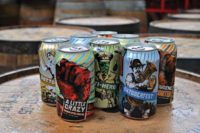Bioplastics: A product evolution or market revolution?

Launched in June 2011, Heinz’s PlantBottle is
one of the best examples of a ‘drop-in’ bioplastic and recycled PET
combination. It resulted from a strategic partnership with The Coca-Cola
Company.
Food & Beverage Packaging: What are the major packaging drivers in bioplastic development and use?
Jeff Timm: The major drivers in bioplastic packaging are incorporated in or are a part of a company’s total sustainability program, which is part of the total brand image. The basic role of a package also plays into bioplastic usage. Features like single-use, attractive end-of-life options, environmental footprint and specific functionality lend themselves to the attributes that bioplastics bring to packaging.
F&BP: Can you provide a definition of what a bioplastic is and maybe what it isn’t?
Timm: There are a number of definitions floating around but I believe the Society of the Plastic Industry (SPI) definition is the one we should all embrace. It states a bioplastic is a plastic that is biodegradable, has bio-based content, or both. The trouble with this definition is that it incorporates two other words–biodegradability and bio-based–that also require definitions. This is why a bioplastic definition is so confusing. A biodegradable plastic is one that undergoes a breakdown of organic material in the presence of microorganisms (bacteria, fungi or algae) usually in a controlled heat and moisture environment. Biodegradation is not thermal, UV or hydro degradation. Bio-based content is the fraction of the carbon content which is “new”carbon content made up of biological materials or agricultural resources versus fossil-derived “old” carbon content. Bio-based content is measured following the procedures set by ASTM D6866. Water soluble plastics like polyvinyl alcohol (PVOH) are not bioplastics.
F&BP: You’ve noted that there’s been a recent shift in what a bioplastic is . . . can you comment further on that?
Timm: The shift is that there are more product offerings falling into the second part of the bioplastic definition: bio-based rather than biodegradable. For example, when bioplastics were first introduced to the marketplace they were almost exclusively biodegradable polymers derived from renewable resources like corn. More recent developments have been bioplastics derived from bio-based, renewable building blocks that are not biodegradable. An example is a drop-in polyethylene polymerized from ethylene that is derived from renewable sugarcane, not petrochemical sources. This shift has added to the marketplace and consumer confusion in understanding what a bioplastic is. A simple way to look at a bioplastic is to separate how it is created vs. its end-of-life outcome. The confusion develops when we combine the creation and disposal in the same definition. Biodegradation and recycling are both end-of- life outcomes. Words like bio-sourced, bio-based and renewable are from the front-end creation side.
F&BP: What are the major misconceptions about bioplastics?
Timm: The biggest misconception is that all bioplastics biodegrade or compost. Bio-based PE derived from renewable bio-based building blocks does not compost. Surveys indicate most consumers associate “doing the right thing” with recyclability, not reducing GHG or using renewable feedstock in the manufacture of plastics. Most of the time recycling has nothing to do with whether a plastic is bio- or petrochemical-derived. In some cases bioplastics can cause harm to traditional plastic recycling streams like PET.
F&BP: What are the realities of this market?
Timm: There are a number of major market realities:
a. First, there’s tremendous confusion surrounding materials, technology and marketing claims. The consumer clearly wants sustainable products. However, when faced with real-world decisions on how to achieve that goal there are confusing marketplace signals. Some packaging companies blatantly mislead consumers with false claims while other companies have tried using bioplastics only to be disappointed by their fitness in use or processing difficulties. Additionally, performance expectations have not been meet in all cases, especially when it comes to compostability. Consumer expectations and actual performance realities have not aligned, creating disappointment.
b. There is inadequate end-of-life (EOL) consumer understanding and expectations around disposal. Many consumers believe biodegradation is simply throwing a bottle out the car window and having it degrade in a relatively short period of time. This is far from reality. The misunderstanding around landfills also leads to confusion. Plastics, including bioplastics, for the most part do not degrade in landfills. A better matching of bioplastics degradation properties and consumer expectations is needed.
c. End-of-life disposal programs need to be developed on a national level. The hodgepodge of local, city and state regulations around recycling and plastic usage and disposal only adds to the confusion. For example, incineration should be part of the public disposal debate, but it rarely is in the U.S.
d. The whole public understanding of green-house-gas (GHG), carbon footprint, “new” carbon vs. “old” carbon layered on top of a discussion on sustainability and the addition of bioplastic applications has been too great an educational burden for the consumer. A simple example: Do the numbers inside the recycle chasing arrows symbol appearing on most plastic packaging identify the type of plastic or that it is recyclable or both? We need to have a collective common understanding in order to make informed decisions.

Timm: The reason confusion abounds is because there are no common acceptable standards or definitions for bioplastic usage, disposal and claims. The whole plastic industry and the subset of the packaging industry is partly responsible for this confusion. Although the term “sustainable packaging” has been used in the marketplace since early this decade, most people in the industry today still cannot define what sustainable packaging is according to the Sustainable Packaging Coalition (SPC) definition.
Also, conflicting claims about end-of-life scenarios are prevalent. Examples: “What actually goes on inside a landfill? Do products really degrade in a landfill or are they simply entombed?” However there is a light at the end of the tunnel. The Consumer Goods Forum-Global Packaging Project (GPP), Federal Trade Commission-Green Guides, ASTM, UL, USDA and other groups are slowly setting standards to bring order to the chaos. The collective goal taken from the introduction of the GPP Report is to bring “common definitions and principles, agreed metrics and indicators and guidance on usage”. In my estimation, this has taken far too long. An example of this is why are municipalities all over this country trying to regulate and ban the use of plastic packaging? Why hasn’t the plastic industry stepped up and presented the value proposition for plastics? They saw this coming years ago.
F&BP: Other than requiring regulatory approval for food contact, are there any differences in bioplastics selected for applications in food and beverages than for other end-use markets?
Timm: The biggest requirement for food packaging is keeping the ingredients safe from outside contaminates and spoilage. To do this, barrier properties are probably the most significant requirement of the food and beverage package. Additional requirements are printability, machinability, and a good balance of physical properties, e.g. toughness and puncture-resistance. The major requirements for many nonfood and beverage durable applications are heat resistance and impact resistance. These are areas where many biodegradable bioplastics suffer, though there are polyhydroxyalkanoates (PHAs) and additive packages employed that increase temperature and impact limits. Drop-in bioplastics discussed earlier would have the same physical properties as their petro counterparts. Finally, injection molding is the least used thermoplastic converting process for the packaging industry compared to extruded and blown film and extruded and cast sheet for thermoforming. As a result of these processing differences, specifications like green strength, draw down, lower melt indexes, etc. are required for packaging applications and may not be necessary for injection molded durable applications. Additionally attributes like clarity and printability (surface features) could be different.

Timm: The biggest opportunity that has only emerged over the last 18 months is the bio-based PET beverage bottle. Both Coke Cola and Pepsi have different bio-based bottle technologies to replace their current PET bottles. These two companies have clearly indicated their marketing plan is to embrace recyclability rather than biodegradability as their disposal method of choice. This is a huge shift away from most early packaging applications that were focused on biodegradability as the end-of-life outcome. If successful, the impact of this shift will create huge market opportunities for bioplastic drop-ins as replacements for petroleum-based materials. The same shift is also occurring with commercially available bio-based polyethylene (PE). Technology is also commercial or near commercial for bio-based nylon, polypropylene, polystyrene, acrylic and many other traditional plastics used in the packaging industry. This does not signal the death of biodegradable bioplastics. It is just the dawning of the next stage of market development after the early stage market confusion and scramble to match food and beverage applications requirements with the bioplastic properties and attributes. There will always be opportunity for all bioplastic families of products. Just like in the traditional petro-plastic industry, one product does not fulfill all application requirements.
F&BP: What’s your biggest piece of advice for packagers?
Timm: The most important piece of advice I can give when considering using a bioplastic is to match the packaging requirements to the bioplastic properties. I don’t mean just the physical and mechanical properties of the bioplastic. Consideration must be given to the end-of-life scenarios: What do you want your customer to do with the package once the contents are gone, and what do you tell the consumer in the shopping aisle about the package claims-compostability, recyclable, percent recycled content, etc? These claims must be supported by data recognized by the industry.
It is a very exciting time to be in the bioplastics market. As suppliers do a better job matching properties to packaging requirements and consumers are more educated, the industry takes control of “speaking points” around plastics’ role in society and a national program hopefully emerges to address end-of-life issues the industry can only grow. F&BP
Jeff Timm has spent more than 35 years in the plastics industry with Fortune 100 companies in positions ranging from sales and marketing research to leadership roles in product and business management and business development. The last six years have been as Managing Principal for Timm Consulting, Franksville, WI, a plastics business and market development consultancy focusing on bioplastics. Timm can be reached at jeff@timmconsulting.net or. www.linkedin.com/in/jefftimm
Top 5 web resources for bioplastics for packaging
Bioplastics expert Jeff Timm offers the following as his Top
5 most useful websites for those developing or using packaging that includes
bioplastics. Sustainable Packaging Coalition, a project of GreenBlue: www.greenblue.org and www.sustainablepackaging.org
Federal Trade Commission (FTC): www.ftc.gov/green
Consumer Goods Forum-Global Packaging Project: www.ciesnet.com and www.globalpackaging.mycgforum.com
A full list of Timm’s 12 suggested websites can be found here: http://cot.ag/iRDNLs
Source: Timm Consulting
Looking for a reprint of this article?
From high-res PDFs to custom plaques, order your copy today!






